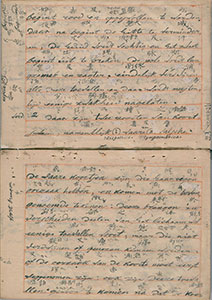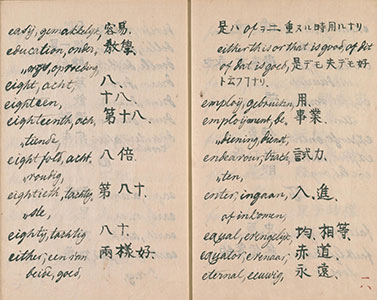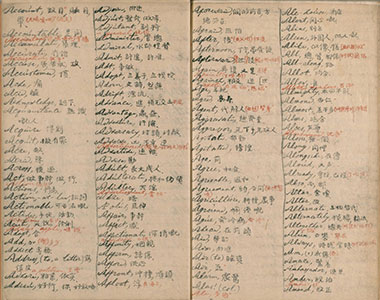Chapter 3 Eyes of science Struggle with the Western languages
Struggle with the Western languages
UDAGAWA Genzui, 1755-1797
 An official doctor for the Tsuyama Domain. After mastering his family business of Chinese Medicine, Genzui had a chance to converse with Katsuragawa Hoshu and Otsuki Gentaku at the age of 25. The experience inspired him to learn Dutch studies. After starting his study under the tutelage of Gentaku, Genzui also pursued his studies with other teachers such as Sugita Gempaku, Maeno Ryotaku and Nakagawa Jun’an. Genzui’s translation work titled Seisetsu naika sen’yo was considered to be the first book to introduce Dutch internal medicine to Japan. He widely informed that Western medicine was excellent not only surgically but also internally.
An official doctor for the Tsuyama Domain. After mastering his family business of Chinese Medicine, Genzui had a chance to converse with Katsuragawa Hoshu and Otsuki Gentaku at the age of 25. The experience inspired him to learn Dutch studies. After starting his study under the tutelage of Gentaku, Genzui also pursued his studies with other teachers such as Sugita Gempaku, Maeno Ryotaku and Nakagawa Jun’an. Genzui’s translation work titled Seisetsu naika sen’yo was considered to be the first book to introduce Dutch internal medicine to Japan. He widely informed that Western medicine was excellent not only surgically but also internally.
30 Johannes de Gorter, Seiyo naika sen'yo (from Ushi Hikyu), translated by UDAGAWA Genzui, [ca. 1789-1801][WA21-14]
Genzui translated the book of internal medicine by Johannes de Gorter (Gezuiverde geneeskonst, of kort onderwys der meeste inwendige ziekten, Amsterdam, 1744) and published it under the title of Seisetsu naika sen’yo from 1793 to 1808. The inserted material is the draft of the book. The original book was owned by Katsuragawa Hoshu. Genzui utilized the Japanese style ruled paper bound in Japanese style, using it sideways in order to write both the original Dutch manuscript and the translated text on the same page. Corrections made with chalk are visible in some parts, showing the efforts he had made in the process of translation, especially when compared to the printed book (see Kotenseki Sogo Database, the Waseda University Library (bunko08 C0026)![]() ). Moreover, the printed version was revised and augmented
). Moreover, the printed version was revised and augmented![]() later by Udagawa Genshin and Fujii Hotei, making the sentences even easier to understand.
later by Udagawa Genshin and Fujii Hotei, making the sentences even easier to understand.
YOSHIO Joen, 1785-1833
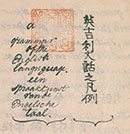 An interpreter of Dutch who resided in Nagasaki, and the son of Yoshio Kogyu, an interpreter and a doctor who had a close relationship with Maeno Ryotaku and Sugita Gempaku. Joen studied under Nakano Ryuho (a.k.a. Shizuki Tadao), a Dutch studies scholar and a former interpreter. Joen also studied French under Hendrik Doeff, who was the chief of the Dutch factory. He also learned English from Jan Cock Blomhoff, the tally clerk of the Dutch factory, who later was promoted to the chief. Joen also participated in editing the Dutch-Japanese dictionary (so-called Zufu Haruma, see Kotenseki Sogo Database, the Waseda University Library
An interpreter of Dutch who resided in Nagasaki, and the son of Yoshio Kogyu, an interpreter and a doctor who had a close relationship with Maeno Ryotaku and Sugita Gempaku. Joen studied under Nakano Ryuho (a.k.a. Shizuki Tadao), a Dutch studies scholar and a former interpreter. Joen also studied French under Hendrik Doeff, who was the chief of the Dutch factory. He also learned English from Jan Cock Blomhoff, the tally clerk of the Dutch factory, who later was promoted to the chief. Joen also participated in editing the Dutch-Japanese dictionary (so-called Zufu Haruma, see Kotenseki Sogo Database, the Waseda University Library![]() ) together with Doeff. When Philipp Franz Balthasar von Siebold came to Nagasaki to teach and to provide medical treatment at Narutakijuku, Joen acted as an interpreter. He also taught Dutch to the students of Narutakijuku, which included Ito Keisuke and Takano Choei.
) together with Doeff. When Philipp Franz Balthasar von Siebold came to Nagasaki to teach and to provide medical treatment at Narutakijuku, Joen acted as an interpreter. He also taught Dutch to the students of Narutakijuku, which included Ito Keisuke and Takano Choei.
31 Robert Morrison, Igirisu bunwa no hanrei, 2 vol, enlarged and transcribed by YOSHIO Joen, [late Edo period][特7-47]
31 Related material: Robert Morrison, A grammar of the English language for the use of the Anglo-Chinese College, Macao: East India Company’s Press, 1823 (reprint ed. Zhengzhou Daxiang chubanshe, 2008)[KK27-C99]
Originally considered to be a work authored by Joen, this particular piece of material turned out to be the transcription of an English textbook for Chinese (see Related material 31) written by a British man named Robert Morrison, who was the first Protestant preacher to visit mainland China. It contained parallel translation in Dutch with Japanese explanatory comments added by Joen. This is an example of the early English studies in Japan, which shows fascinating evidence of Dutch and Chinese being used as intermediaries. Furthermore, the inserted material is the actual copy that was given to Ito Keisuke, who was studying Dutch in Narutakijuku in Nagasaki, from Joen, who was the host of where Keisuke lodged in 1827.
NISHIMURA Shigeki, 1828-1902
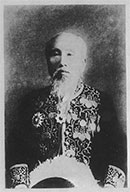 A philosopher and a son of a feudal retainaer of the Sakura Domain. Nishimura studied Confucianism and artillery in his childhood and later learned Dutch and English studies. Following the Meiji Restoration, he started serving at the Ministry of Education from 1873. Nishimura also played the central role in the establishment of Meirokusha (an academic enlightenment group formed in 1873). He appealed to the public the importance of the restoration of national morality in reaction to the government’s tendency to Westernization. Nishimura eventually established Tokyo Shushingakusha in 1876, which later evolved into Nihon Kodokai. He published literary works such as Nihon dotokuron (lit. Japanese Moral Theory)
A philosopher and a son of a feudal retainaer of the Sakura Domain. Nishimura studied Confucianism and artillery in his childhood and later learned Dutch and English studies. Following the Meiji Restoration, he started serving at the Ministry of Education from 1873. Nishimura also played the central role in the establishment of Meirokusha (an academic enlightenment group formed in 1873). He appealed to the public the importance of the restoration of national morality in reaction to the government’s tendency to Westernization. Nishimura eventually established Tokyo Shushingakusha in 1876, which later evolved into Nihon Kodokai. He published literary works such as Nihon dotokuron (lit. Japanese Moral Theory)![]() . As the president of Nihon Kodokai ,Nishimura promoted the national morality based on Confucianism and respect for the Imperial family. The National Diet Library holds 86 items totaling 206 volumes of Nishimura-related materials, including his autograph manuscripts.
. As the president of Nihon Kodokai ,Nishimura promoted the national morality based on Confucianism and respect for the Imperial family. The National Diet Library holds 86 items totaling 206 volumes of Nishimura-related materials, including his autograph manuscripts.
32 John Chalmers, Ei-estu jiten, transcribed by NISHIMURA Shigeki, [end of the Edo period][827-128]
This is a copy of an English-Cantonese dictionary. Vermillion-colored parentheses that do not appear in the original (see Related material 32) indicate the pronunciation of English words described by the sounds of Southern Chinese, and were added by Nishimura. In his autobiography titled Ojiroku![]() , Nishimura stated that he had started Dutch and English studies in 1861, and “used all of his free time at hand to transcribe Western dictionaries in order to prepare for what may come in the future”, and that “since many people at the time hated Western studies, it was of the utmost necessity to keep it secret that I was studying it. Moreover, the reference materials including dictionaries were never sufficient, and I had to waste labor on useless matters”.
, Nishimura stated that he had started Dutch and English studies in 1861, and “used all of his free time at hand to transcribe Western dictionaries in order to prepare for what may come in the future”, and that “since many people at the time hated Western studies, it was of the utmost necessity to keep it secret that I was studying it. Moreover, the reference materials including dictionaries were never sufficient, and I had to waste labor on useless matters”.
32 Related material:John Chalmers, An English and Cantonese pocket‐dictionary = Ei-etsu Jiten, Hong Kong: London missionary society’s press, 1862 (2d. ed.)[495.1-C438e]




